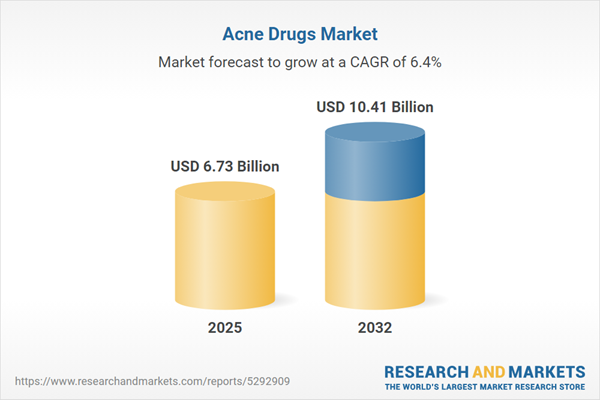Speak directly to the analyst to clarify any post sales queries you may have.
The global acne drugs market is evolving rapidly in response to shifting healthcare requirements and technological expansion. Modern decision-makers face increasing complexity as they navigate product innovation, regulatory dynamics, and supply chain factors while addressing diverse patient demands.
Market Snapshot: Acne Drugs Market Size and Growth Trajectory
The Acne Drugs Market grew from USD 6.32 billion in 2024 to USD 6.73 billion in 2025. It is projected to continue expanding at a CAGR of 6.43%, reaching USD 10.41 billion by 2032. This upward trend is driven by robust demand for safe, efficacious therapies, evolving regulatory pathways, and ongoing advances in drug delivery technologies. The competitive landscape is rapidly changing as stakeholders pursue innovation, positioning themselves to capture expanding regional and demographic segments.
Scope & Segmentation
- Drug Types: Hormonal agents, oral antibiotics, oral retinoids, topical antibiotics (clindamycin, erythromycin), topical retinoids (adapalene, tazarotene, tretinoin).
- Treatment Categories: Over-the-counter options and prescription therapies for different severity levels.
- Acne Types: Mild, moderate, and severe acne stratification guides therapy and dosing.
- Distribution Channels: Hospital pharmacies, online pharmacies, retail outlets (chain and independent).
- Patient Demographics: Adolescents, adults, pediatric populations.
- End-Users: Cosmetic clinics and med spas, dermatologists, hospitals and outpatient centers, individual consumers.
- Geographic Regions: Americas (United States, Canada, Mexico, Latin America: Brazil, Argentina, Chile, Colombia, Peru), Europe, Middle East & Africa (including United Kingdom, Germany, France, Russia, Italy, Spain, Netherlands, Sweden, Poland, Switzerland, UAE, Saudi Arabia, Qatar, Turkey, Israel, South Africa, Nigeria, Egypt, Kenya), Asia-Pacific (China, India, Japan, Australia, South Korea, Indonesia, Thailand, Malaysia, Singapore, Taiwan).
- Leading Companies: Galderma Laboratories, L.P., Bayer Aktiengesellschaft, Johnson & Johnson Services, Inc., Bausch Health Companies Inc., GlaxoSmithKline plc, Sun Pharmaceutical Industries Limited, Teva Pharmaceutical Industries Limited, AbbVie Inc., Pfizer Inc., Novartis AG.
Key Takeaways: Strategic Insights for the Acne Drugs Market
- Therapeutic innovation is advancing through new molecular approaches, improved formulations, and digital health integration, enhancing differentiation and adherence.
- Adaptive regulatory pathways and expedited approvals facilitate faster market entry for novel agents yet impose requirements for post-market monitoring and real-world evidence.
- New US tariff regulations have increased complexity in sourcing strategies and manufacturing costs, especially impacting supply chains reliant on international intermediates.
- Companies are actively pursuing cross-disciplinary collaborations and partnerships, enabling faster translation of research into clinical applications.
- Regional nuances—such as reimbursement policies, local manufacturing, and channel dynamics—drive tailored commercial strategies and market access planning.
- Sustainability considerations are guiding investments in production processes and green chemistry, aligning with shifting stakeholder expectations.
Tariff Impact: Adjustments in Supply Chains and Sourcing
The implementation of revised US import duties on acne drug components in 2025 has prompted manufacturers to reevaluate procurement and supply routes. Larger businesses are adapting with alternative sourcing, while smaller manufacturers explore strategic partnerships or contract manufacturing to sustain competitiveness. Distributors and pharmacies, in turn, respond with pricing model revisions and inventory management strategies to maintain product continuity.
Methodology & Data Sources
This market analysis is supported by a multimodal research approach that combines in-depth interviews with primary industry stakeholders and comprehensive review of secondary sources, including clinical research, regulatory updates, and proprietary database modeling. Analytical protocols ensure reliability through cross-validation, blinded data coding, and scenario testing.
Why This Report Matters: Actionable Intelligence for Strategic Decisions
- Enables senior leaders to identify growth opportunities by providing detailed segmentation and regional dynamics for effective portfolio planning.
- Supports risk mitigation through intelligence on regulatory shifts, tariff impacts, and supply chain resilience initiatives.
- Delivers clarity on competitive trends, enabling proactive commercial strategy alignment in a complex market environment.
Conclusion
The acne drugs market is shaped by diverse influences including technology, regulation, patient preferences, and economic shifts. Proactive adaptation, data-driven strategy, and collaborative innovation remain essential for stakeholders navigating this evolving environment.
Additional Product Information:
- Purchase of this report includes 1 year online access with quarterly updates.
- This report can be updated on request. Please contact our Customer Experience team using the Ask a Question widget on our website.
Table of Contents
3. Executive Summary
4. Market Overview
7. Cumulative Impact of Artificial Intelligence 2025
Companies Mentioned
The companies profiled in this Acne Drugs market report include:- Galderma Laboratories, L.P.
- Bayer Aktiengesellschaft
- Johnson & Johnson Services, Inc.
- Bausch Health Companies Inc.
- GlaxoSmithKline plc
- Sun Pharmaceutical Industries Limited
- Teva Pharmaceutical Industries Limited
- AbbVie Inc.
- Pfizer Inc.
- Novartis AG
Table Information
| Report Attribute | Details |
|---|---|
| No. of Pages | 183 |
| Published | October 2025 |
| Forecast Period | 2025 - 2032 |
| Estimated Market Value ( USD | $ 6.73 Billion |
| Forecasted Market Value ( USD | $ 10.41 Billion |
| Compound Annual Growth Rate | 6.4% |
| Regions Covered | Global |
| No. of Companies Mentioned | 11 |









